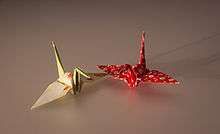Washi

Washi (和紙) is a style of paper that was first made in Japan. Washi is commonly made using fibers from the bark of the gampi tree, the mitsumata shrub (Edgeworthia chrysantha), or the paper mulberry, but also can be made using bamboo, hemp, rice, and wheat. The word "washi" comes from wa 'Japanese' and shi 'paper', and the term is used to describe paper made by hand in the traditional manner.[1] As a Japanese craft it registered as a UNESCO intangible cultural heritage.[2]
Washi is generally tougher than ordinary paper made from wood pulp, and is used in many traditional arts. Origami, Shodo, and Ukiyo-e were all produced using washi. Washi was also used to make various everyday goods like clothes, household goods, and toys as well as vestments and ritual objects for Shinto priests and statues of Buddha. It was even used to make wreaths that were given to winners in the 1998 Winter Paralympics. Several kinds of washi, referred to collectively as Japanese tissue, are used in the conservation and mending of books.
Manufacture
Washi is produced in a way similar to that of ordinary paper, but relies heavily on manual methods. It involves a long and intricate process that is often undertaken in the cold weather of winter, as pure, cold running water is essential to the production of washi. Cold inhibits bacteria, preventing the decomposition of the fibres. Cold also makes the fibres contract, producing a crisp feel to the paper. It is traditionally the winter work of farmers, a task that supplemented a farmer's income.
Kozo, a type of mulberry, is the most commonly used fiber in making Japanese paper. The kozo branches are boiled and stripped of their outer bark, and then dried. The fibers are then boiled with lye to remove the starch, fat and tannin, and then placed in running water to remove the lye. The fibers are then bleached (either with chemicals or naturally, by placing it in a protected area of a stream) and any remaining impurities in the fibers are picked out by hand. The kozo is laid on a rock or board and beaten.
Wet balls of pulp are mixed in a vat with water (and, in some cases, neri, which is a mucilaginous material made from the roots of the tororo plant) and one of two traditional methods of paper making (nagashi-zuki or tame-zuki) is employed. In both methods, pulp is scooped onto a screen and shaken to spread the fibers evenly. Nagashi-zuki (which uses neri in the vat) produces a thinner paper, while tame-zuki (which does not use neri) produces a thicker paper.
Types
With enough processing, almost any grass or tree can be made into a washi. Gampi, mitsumata, and paper mulberry are three popular sources.[3]
- Ganpishi (雁皮紙) - In ancient times, it was called Hishi (斐紙). Ganpishi has a smooth, shiny surface and is used for books and crafts.
- Kozogami (楮紙) - Kozogami is made from paper mulberry and it is the most widely made type of washi. It has a toughness closer to cloth than to ordinary paper and does not weaken significantly when treated to be water-resistant.
- Mitsumatagami (三椏紙) - Mitsumatagami has an ivory-colored, fine surface and is used for shodo as well as printing. It was used to print paper money in Meiji period.
Applications
Until the early 20th century, the Japanese used washi in applications where wood pulp paper or other materials are currently used. This is partly because washi was cheaper, but also because the unique characteristics of washi made it a better material. The different uses of washi are too numerous to mention, but include the following:
Art
- Chiyogami — a method of stenciling or screenprinting paper with traditional Japanese designs
- Ikebana — the art of flower arrangement, also known as kadō
- Inkjet printings
- Katazome — a method of dyeing fabrics using a resist paste
- Kitemaking
- Mokuhanga (Japanese wood printing)
- Nihonga (Japanese paintings)
- Origami — the art of paper folding
- Printmaking
- Sculpture
- Sewing
- Shibori — several methods of dyeing cloth with a pattern
- Shodo — the art of calligraphy
- Sumi-e — the art of Ink wash painting
- Sumingashi — a form of paper marbling
- Ukiyo-e — a genre of woodblock prints
- Washi eggs — covering eggs with washi paper
- Chigirie - using Washi for "painting" pictures
Clothing
Cuisine
Furniture
Objects
- Bags
- Bento box
- Harae-Gushi, the washi whisk used for ritual purification by Shinto priests
- Japanese banknotes
- Loudspeaker cones. Mitsubishi
- Ofuda for Shinto
- Plates
- Scale models
- Toys
- Umbrellas
- Printing
Events
Weaponry
Manufacturers
- Gundo gami (Akiruno, Tokyo)
- Awa washi (Tokushima)
- Ecchu washi (Toyama)
- Echizen washi (Echizen, Fukui)
- IseWashi (Ise, Mie)
- Mino washi (Gifu)
- Sekisyū washi (Hamada, Shimane)
- Sugihara gami (Taka, Hyōgo)
- Tosa washi (Kochi)
- Yame washi (Fukuoka)
- Uchiyama gami (Iiyama, Nagano)
See also
Further reading
The major Western-language book (360 pages) on all aspects of traditional Japanese papermaking still appears to be the 1978 publication by Sukey Hughes.[4] Its extensive bibliography cites numerous other sources on diverse aspects of the subject up to its publication in 1978.
Notes and references
- ↑ Hughes, Sukey (1978). Washi: the world of Japanese paper. Tokyo: Kodansha International. ISBN 0-87011-318-6.
- ↑ Government, paper makers welcome addition of ‘washi’ to UNESCO list
- ↑ Hughes, Sukey (1978). Washi: the world of Japanese paper. Tokyo: Kodansha International. ISBN 0-87011-318-6.
- ↑ Hughes, Sukey (1978). Washi: the world of Japanese paper. Tokyo: Kodansha International. ISBN 0-87011-318-6.
